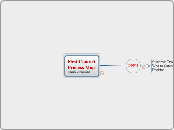First ContactProcess Map(othomoas@mit.edu)
I found this map in the web as a good example of a process. I transfered the process into Mindomo to show, how a process can be builded in Mindomo.
OPEN
Definition: A {case|request for action|problem|need} springs into existence,either through customer action or an external trigger.o Customer issues vary from "trivial" to "substantive" (e.g. MIT-business-relatedvs. listening to FM radio in Real Player)o Expectationso Each group deals with different sets of customerso Customer Outreach
Customer TriageWho-to ContactDecision
Definition: The customer does triage; this can take the form of formal triageand problem analysis, or be a simple who-to-contact decision based onhistorical or other available date.o Difficult for customers to triage; may misdirect themselves; frustration builds upduring this part of processo Should the customer have to do triage at all?o What makes a customer choose a particular avenue of support?o How hard is Information Systems to navigate (i.e. who do I contact for what)?o Customers build an affinity towards particular groups or people who have servedthem well in the pasto Certain groups also proactively seek out certain customerso Process is relationship-driveno Willingness to hand off varies due to differing expectations around the results ofdoing soo Lack of formal expectations across teams and interfaces
KnowledgeManagement
Contact with ISis made(Self Service)
Contact with ISis made(Personal)
Definition: Contact with Information Systems is made; this contact may bewith a first-contact team or with someone in a first-contact role but outsidethe formal first-contact teams.o Customer sets own context, picks a contact to makeo Initial contact with I.S. is an area rife with improvement opportunitieso Some customers prefer non-interactive methods (email); in Athena Consultingand Accounts, 95% electronico Some customers really want to talk to someoneo Electronic contact works better for I.S., as it forces more (up front) clarificationfrom the customero We are often not as available during off-hours (home users, students, etc.)o Broad spectrum of customers and customer diversity demand diverse, parallel,and efficient ways to contact ISo Improvement opportunities exist in areas of: support technologies, consistency,training
Classify
Definition: The case is classified into one of six (following) buckets; this iscurrently often not a formal step in the process, but would benefit from beinga formal, explicit step.o Reference (Request for information; status; solution to known and documentedproblem)o Customer was misdirected: Divert (give customer info; really sub-set ofReference)o Consulting / Real-Timeo Request for Action / Transaction / Resourceso Problem-Solvingo Referral / handoff (how do we define these terms?)o Escalationo A single request may move through multiple classification iterations
Reference
Definition: A type “Reference” case involves the lookup, retrieval, andtransmission of existing, managed information; it does not involve problemsolving or extensive research.o Technology not integrated (Casetracker-KB link)o No knowledge-base tool that includes all [knowledge]o Problem Queueo Tighter feedback loop between problem solving and referenceo First contact based on who you knowo Potential improvement opportunity: everyone does lookups/is able to do lookups[in the knowledge base]o "Lookups" can also mean getting info from another person (the knowledge inpeople's heads
Action
Refer(open...close)
Proxy(open...close)
Deliver
Verify
Close
ResearchProblem SolvingTroubleshooting
Clarify
Local DepartmentSupport
